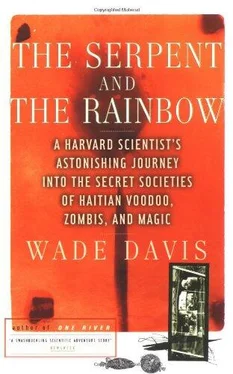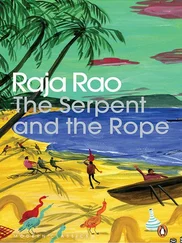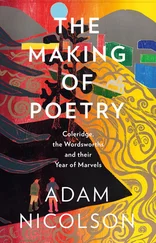Wade Davis - The Serpent and the Rainbow
Здесь есть возможность читать онлайн «Wade Davis - The Serpent and the Rainbow» весь текст электронной книги совершенно бесплатно (целиком полную версию без сокращений). В некоторых случаях можно слушать аудио, скачать через торрент в формате fb2 и присутствует краткое содержание. Год выпуска: 1985, Издательство: Simon & Schuster, Жанр: Старинная литература, на английском языке. Описание произведения, (предисловие) а так же отзывы посетителей доступны на портале библиотеки ЛибКат.
- Название:The Serpent and the Rainbow
- Автор:
- Издательство:Simon & Schuster
- Жанр:
- Год:1985
- ISBN:нет данных
- Рейтинг книги:5 / 5. Голосов: 1
-
Избранное:Добавить в избранное
- Отзывы:
-
Ваша оценка:
- 100
- 1
- 2
- 3
- 4
- 5
The Serpent and the Rainbow: краткое содержание, описание и аннотация
Предлагаем к чтению аннотацию, описание, краткое содержание или предисловие (зависит от того, что написал сам автор книги «The Serpent and the Rainbow»). Если вы не нашли необходимую информацию о книге — напишите в комментариях, мы постараемся отыскать её.
The Serpent and the Rainbow — читать онлайн бесплатно полную книгу (весь текст) целиком
Ниже представлен текст книги, разбитый по страницам. Система сохранения места последней прочитанной страницы, позволяет с удобством читать онлайн бесплатно книгу «The Serpent and the Rainbow», без необходимости каждый раз заново искать на чём Вы остановились. Поставьте закладку, и сможете в любой момент перейти на страницу, на которой закончили чтение.
Интервал:
Закладка:
11
Tell My Horse
IT HAPPENED on a plantation near Limbé in the year 1740. At first even the man himself did not notice the iron rollers of the cane press flush crimson with his own blood. By the time the child’s scream alerted the driver to slice the leather traces connecting the horse to the shaft of the mill, the arm was crushed to the shoulder, and the blood mixed freely with the sweet sap of the cane. Pain was not new to the slave, and what he felt now was numbed by the rage of an intolerable impotence. His free hand flailed at the press, and with all the force of his sinuous body he pulled back, reversing the rollers, withdrawing fragments of his mangled arm. Delirium took him, leading him back on a hallucinatory passage to the land of his birth, to the Kingdoms of Fula and Mandingo, to the great cities of Guinea, the fortresses and vast markets that drew traders from an entire continent and beyond, the temples that made a mockery of the paltry buildings in which the French worshipped their feeble god. He never noticed the rope tourniquet placed around his shoulder to seal the flow of blood, nor did he hear the call for the machete that would complete the crude work of the press. He felt only the beginnings of the sound, of a single syllable rising from the base of his bloodstained legs, recoiling through the hollow of his gut until what left his lips was no longer his. It was the wrathful call of crystallized hatred, a cry of vengeance, not for himself, but for an entire people stolen from Africa and dragged in chains to the Americas to work land stolen from the Indians.
François Macandal should have died, but the Mandingue slave was no ordinary man. Even before the accident he was a leader among the slaves of the northern district around Limbé. By day, they had watched him endure the cruelties of the overseers with indifference, his bloodshot eyes casting scorn at the whips of knotted cord, or the stretched and dried penis of a bull. By night he had calmed the people with his eloquence, spinning tales of Guinée that had emboldened even the most dispirited of men. When he spoke people considered it an honor to sit by his side, and as he slept the women vied for the chance to share his bed, for his dreams were revelations that allowed him and those by him to see into the future. But it was the fearless way Macandal endured the accident in the mill that confirmed what the people had always suspected. Only the whites could fail to note that Macandal was immortal, an envoy of the gods who would never be vanquished.
The accident freed Macandal to wander. No longer fit to work in the fields, he was made a herder and sent out each daybreak to drive the cattle into their mountain pastures. No one knew what he did during the long hours away from the plantation. Some said he discovered the magic in plants, foraging for leaves that mimicked the herbs he had known in Africa. Others said he sought out the old masters who dwelled in caves, whose footsteps alone caused the earth to tremble. Only one thing was certain. Macandal in his wanderings was not alone, for the mountains around Limbé were one of the refuges of the thousands of Africans who had fled the plantations, runaway slaves with a price on their heads and known to the French as Maroons.
Bloated by wealth unlike anything seen since the early days of the conquest, the colonial planters of Saint Domingue made an institution of cruelty. Field hands caught eating cane were forced to wear tin muzzles while they worked. Runaways had their hamstrings sliced. Brandings, indiscriminate floggings, rape, and killings were a matter of course, and for the slightest infraction a man was hung from a nail driven through his ear. Slaves like cane were grist for the mill, and the death toll in some years rose as high as eighteen thousand. The documented excesses of certain owners almost defy belief. One slave was kept in chains for twenty-five years. A notorious planter was known always to carry a hammer and nails just to be prepared to hang from the trees the severed ears of those he punished. Other common tortures included spraying the flesh with boiling cane syrup, sewing the lips together with brass wire, castration and sexual mutilation of both men and women, live burial, binding men—their skin glazed with molasses—across the paths of ants, enclosing people in barrels with inward protruding nails, and stuffing the anus with gunpowder which was then ignited, a practice common enough to give rise to the colloquial expression “blasting a black’s ass.” So systemic was the abuse of the slaves that it supported a profession of executioners whose fees were regulated by law. The charge to burn a man alive, for example, was set at sixty French pounds. A hanging was only thirty, and for a mere five pounds you could have a slave branded and his ears cut off.
Such savagery was the rule, not the exception, and the fact that first the Indians and then thousands of indentured whites—petty thieves, convicts, or simply urban poor kidnapped in the port cities of Europe—had toiled in servitude before them did little to still the rage of the Africans. Forced labor was the foundation of an economic system that knew no color boundaries; like an open sore the plantations grew upon the Caribbean, and when the Indians died, and the supply of white trash failed to meet demand, the merchants tapped deeper into Africa, drawing away men and women not because they were black, but because they were cheap, limitless in number, and better. European class societies whose elite thought nothing of hanging an English child for petty theft, or packing indentured workers, white or black, like herring into the festering holds of ships, cared less about the origins of their laborers than the production of their labor. Slavery was not born of racism; rather, racism was the consequence of slavery. In the first days of colonialism, when the merchants sailed away from the insular world of Europe, the color of the worker’s skin meant no more to them than it did to the kings of Africa, rulers who lorded over thousands of their own slaves, and who for a suitable profit were more than willing to pass them along. Of course, all of this mattered little to the men and women unloaded into bondage in Saint Domingue. For them the enemy had a face, and there was no doubt as to its color.
Confronted by unrelenting intimidation and torture, the options of the slaves were few. Those who chose to submit and endure did what was necessary to ease their plight: self-inflicted wounds allowed a respite from the brutal labor in the fields, women gave themselves to the overseers, or spared their unborn children by practicing abortion. Others sought immediate relief in suicide. But those who could not be broken and whose desire for freedom drove them to accept desperate measures fled the plantations under the cover of night. Some remained close by, hiding out by day and dependent on the collusion of their families and friends that remained behind. Others, especially the skilled workers fluent in Creole, slipped into anonymity in the cities, passing themselves off as freedmen and seeking work among the faceless crowds in the markets or on the docks. Still others made for the Spanish frontier of Santo Domingo, overland across the savannas and mountains and through the dense forests that still blanketed the island. Like stray cattle, these runaways were but a nuisance to the planters, readily dealt with by professional bounty hunters and their dogs. If recaptured on the fringe of the plantation, they were simply returned to be flogged and publicly humiliated, made to kneel outside the white man’s church to beg forgiveness for “insubordination to the situation in which God had placed him.” Should the runaway be unfortunate enough to be discovered some distance away, or should he resist capture, he was summarily killed—shot and ravaged by the hounds—once his identifying brand had been sliced away from his skin.
Читать дальшеИнтервал:
Закладка:
Похожие книги на «The Serpent and the Rainbow»
Представляем Вашему вниманию похожие книги на «The Serpent and the Rainbow» списком для выбора. Мы отобрали схожую по названию и смыслу литературу в надежде предоставить читателям больше вариантов отыскать новые, интересные, ещё непрочитанные произведения.
Обсуждение, отзывы о книге «The Serpent and the Rainbow» и просто собственные мнения читателей. Оставьте ваши комментарии, напишите, что Вы думаете о произведении, его смысле или главных героях. Укажите что конкретно понравилось, а что нет, и почему Вы так считаете.












